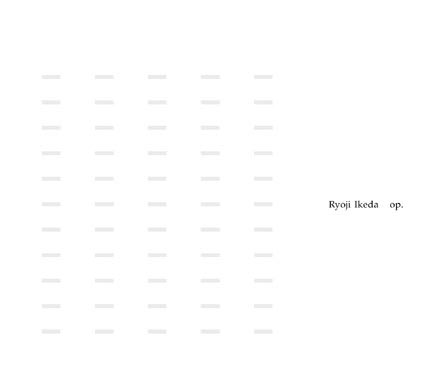ryoji ikeda, "op."
Touch
 Whether or not Ryoji Ikeda has an academic degree in classicalcomposition is irrelevant, the man has proven that he has an ear forsound and how to develop it nicely, using the sources he has to theirfullest. This, to me, is quite the opposite of an irritating trend ofmodern experimental academia in the sense that numerous composers andmusicians will insist that their authority be respected with a largeamount of literature to digest before the first notes are even heard.(Just think of all the people commissioned to record bridges only tofilter the sounds through whatever effects units they own.) Even withthis album, which is a grand departure from Ikeda's style, thepackaging remains simple with only enough text necessary. In the past,Ikeda's music has been composed entirely of wave tones, clicks, andother sounds that simply do not occur in nature. This time, however,there are absolutely no electronic sounds used. "Op. 1" is the firstpart, and is composed for 9 strings in four movements. The piece isn'tentirely unlike his electronic music, introduced with a piercing pitch,but this time it's provided by a solo violin high on the fingerboard.The individual note is played and another follows, the cycle becomesrhythmically repeated while the notes change, accompanied by anotherviolin in abrasive minor intervals. Soon, the violins are joined withthe lower tones of viola, cello and the drone of a double bass. Also,in a similar way to his electronic recordings, the distinguishingendpoints of various movements are practically inaudible, onlyobservable by watching the CD player click through index points. "Op.2," and "Op. 3" follow, each reduced to only a string quartet. Therhtyhm from "Op. 1" is left behind but the tone exploitation remains.Once again, on "Op. 2," never at one point do individual players movefrom note to note without pausing. This time, however, the differentinstruments play at staggered times, like watching raindrops fall tothe ground in slow motion, one by one. "Op. 3" is probably the mostdeveloped piece, despite it being about half the length of the others.Here, each instrument takes turns making their attempts at simple andshort, four-note melodic phrases. High-pitched piercing drones arereintroduced which contrast nicely to low melodic phrases played by thecello. The disc ends with a prototype of "Op. 1," played only by athree-piece of violin, viola and cello. The piercing notes and rhythmicsynergy is remeniscent of the more fully figured version firstappearing on the disc and the composition is almost entirely identical,but this time I sense a bit of post-production here with only smallhints of effects added on afterwards. While this one is noted as theprototype, it seems more emotional, more disturbing and unsettling yetmore connected. Perhaps it's Ikeda's smug way of proving that while hecan do it with a bigger ensemble, he's still quite capable of gettingmore out of less.
Whether or not Ryoji Ikeda has an academic degree in classicalcomposition is irrelevant, the man has proven that he has an ear forsound and how to develop it nicely, using the sources he has to theirfullest. This, to me, is quite the opposite of an irritating trend ofmodern experimental academia in the sense that numerous composers andmusicians will insist that their authority be respected with a largeamount of literature to digest before the first notes are even heard.(Just think of all the people commissioned to record bridges only tofilter the sounds through whatever effects units they own.) Even withthis album, which is a grand departure from Ikeda's style, thepackaging remains simple with only enough text necessary. In the past,Ikeda's music has been composed entirely of wave tones, clicks, andother sounds that simply do not occur in nature. This time, however,there are absolutely no electronic sounds used. "Op. 1" is the firstpart, and is composed for 9 strings in four movements. The piece isn'tentirely unlike his electronic music, introduced with a piercing pitch,but this time it's provided by a solo violin high on the fingerboard.The individual note is played and another follows, the cycle becomesrhythmically repeated while the notes change, accompanied by anotherviolin in abrasive minor intervals. Soon, the violins are joined withthe lower tones of viola, cello and the drone of a double bass. Also,in a similar way to his electronic recordings, the distinguishingendpoints of various movements are practically inaudible, onlyobservable by watching the CD player click through index points. "Op.2," and "Op. 3" follow, each reduced to only a string quartet. Therhtyhm from "Op. 1" is left behind but the tone exploitation remains.Once again, on "Op. 2," never at one point do individual players movefrom note to note without pausing. This time, however, the differentinstruments play at staggered times, like watching raindrops fall tothe ground in slow motion, one by one. "Op. 3" is probably the mostdeveloped piece, despite it being about half the length of the others.Here, each instrument takes turns making their attempts at simple andshort, four-note melodic phrases. High-pitched piercing drones arereintroduced which contrast nicely to low melodic phrases played by thecello. The disc ends with a prototype of "Op. 1," played only by athree-piece of violin, viola and cello. The piercing notes and rhythmicsynergy is remeniscent of the more fully figured version firstappearing on the disc and the composition is almost entirely identical,but this time I sense a bit of post-production here with only smallhints of effects added on afterwards. While this one is noted as theprototype, it seems more emotional, more disturbing and unsettling yetmore connected. Perhaps it's Ikeda's smug way of proving that while hecan do it with a bigger ensemble, he's still quite capable of gettingmore out of less.
 Whether or not Ryoji Ikeda has an academic degree in classicalcomposition is irrelevant, the man has proven that he has an ear forsound and how to develop it nicely, using the sources he has to theirfullest. This, to me, is quite the opposite of an irritating trend ofmodern experimental academia in the sense that numerous composers andmusicians will insist that their authority be respected with a largeamount of literature to digest before the first notes are even heard.(Just think of all the people commissioned to record bridges only tofilter the sounds through whatever effects units they own.) Even withthis album, which is a grand departure from Ikeda's style, thepackaging remains simple with only enough text necessary. In the past,Ikeda's music has been composed entirely of wave tones, clicks, andother sounds that simply do not occur in nature. This time, however,there are absolutely no electronic sounds used. "Op. 1" is the firstpart, and is composed for 9 strings in four movements. The piece isn'tentirely unlike his electronic music, introduced with a piercing pitch,but this time it's provided by a solo violin high on the fingerboard.The individual note is played and another follows, the cycle becomesrhythmically repeated while the notes change, accompanied by anotherviolin in abrasive minor intervals. Soon, the violins are joined withthe lower tones of viola, cello and the drone of a double bass. Also,in a similar way to his electronic recordings, the distinguishingendpoints of various movements are practically inaudible, onlyobservable by watching the CD player click through index points. "Op.2," and "Op. 3" follow, each reduced to only a string quartet. Therhtyhm from "Op. 1" is left behind but the tone exploitation remains.Once again, on "Op. 2," never at one point do individual players movefrom note to note without pausing. This time, however, the differentinstruments play at staggered times, like watching raindrops fall tothe ground in slow motion, one by one. "Op. 3" is probably the mostdeveloped piece, despite it being about half the length of the others.Here, each instrument takes turns making their attempts at simple andshort, four-note melodic phrases. High-pitched piercing drones arereintroduced which contrast nicely to low melodic phrases played by thecello. The disc ends with a prototype of "Op. 1," played only by athree-piece of violin, viola and cello. The piercing notes and rhythmicsynergy is remeniscent of the more fully figured version firstappearing on the disc and the composition is almost entirely identical,but this time I sense a bit of post-production here with only smallhints of effects added on afterwards. While this one is noted as theprototype, it seems more emotional, more disturbing and unsettling yetmore connected. Perhaps it's Ikeda's smug way of proving that while hecan do it with a bigger ensemble, he's still quite capable of gettingmore out of less.
Whether or not Ryoji Ikeda has an academic degree in classicalcomposition is irrelevant, the man has proven that he has an ear forsound and how to develop it nicely, using the sources he has to theirfullest. This, to me, is quite the opposite of an irritating trend ofmodern experimental academia in the sense that numerous composers andmusicians will insist that their authority be respected with a largeamount of literature to digest before the first notes are even heard.(Just think of all the people commissioned to record bridges only tofilter the sounds through whatever effects units they own.) Even withthis album, which is a grand departure from Ikeda's style, thepackaging remains simple with only enough text necessary. In the past,Ikeda's music has been composed entirely of wave tones, clicks, andother sounds that simply do not occur in nature. This time, however,there are absolutely no electronic sounds used. "Op. 1" is the firstpart, and is composed for 9 strings in four movements. The piece isn'tentirely unlike his electronic music, introduced with a piercing pitch,but this time it's provided by a solo violin high on the fingerboard.The individual note is played and another follows, the cycle becomesrhythmically repeated while the notes change, accompanied by anotherviolin in abrasive minor intervals. Soon, the violins are joined withthe lower tones of viola, cello and the drone of a double bass. Also,in a similar way to his electronic recordings, the distinguishingendpoints of various movements are practically inaudible, onlyobservable by watching the CD player click through index points. "Op.2," and "Op. 3" follow, each reduced to only a string quartet. Therhtyhm from "Op. 1" is left behind but the tone exploitation remains.Once again, on "Op. 2," never at one point do individual players movefrom note to note without pausing. This time, however, the differentinstruments play at staggered times, like watching raindrops fall tothe ground in slow motion, one by one. "Op. 3" is probably the mostdeveloped piece, despite it being about half the length of the others.Here, each instrument takes turns making their attempts at simple andshort, four-note melodic phrases. High-pitched piercing drones arereintroduced which contrast nicely to low melodic phrases played by thecello. The disc ends with a prototype of "Op. 1," played only by athree-piece of violin, viola and cello. The piercing notes and rhythmicsynergy is remeniscent of the more fully figured version firstappearing on the disc and the composition is almost entirely identical,but this time I sense a bit of post-production here with only smallhints of effects added on afterwards. While this one is noted as theprototype, it seems more emotional, more disturbing and unsettling yetmore connected. Perhaps it's Ikeda's smug way of proving that while hecan do it with a bigger ensemble, he's still quite capable of gettingmore out of less.



